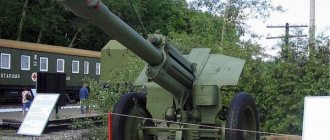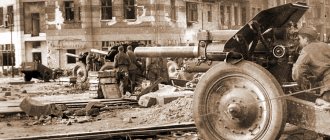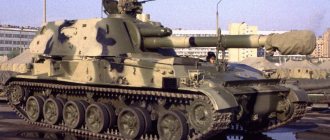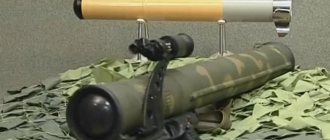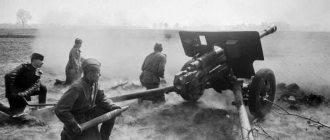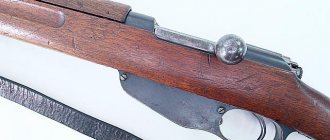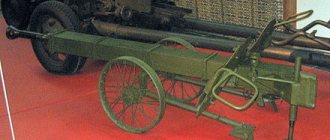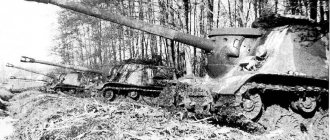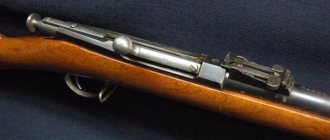| 203 mm howitzer gun model 1931 (B-4) | |
| general information | |
| A country | USSR |
| Years of manufacture | 1937-1941 |
| Issued, pcs. | 889 |
| Weight and dimensions characteristics | |
| Caliber, mm | 203, 4 |
| Barrel length, club | 5087/25 |
| Weight in firing position, kg | 17700 |
| Weight in stowed position, kg | 19000 |
| Firing angles | |
| Elevations (max.), ° | 60 |
| Decrease (min.), ° | 0 |
| Horizontal, ° | 8 |
| Fire capabilities | |
| Max. firing range, km | 17, 890 |
| Rate of fire, rds/min | 1 shot in 2 minutes |
B-4
(GAU index -
52-G-625
) is a Soviet high-power howitzer of 203.4 caliber (8 inches).
The full official name of the gun is 203 howitzer, model 1931. During the Soviet-Finnish War, this weapon was used to destroy bunkers and bunkers along the Mannerheim Line. It was actively and successfully used in the Great Patriotic War, thanks to its power, excellent ballistics of 1-12 variable charges and an elevation angle of 60°, it ensured the choice of the optimal trajectory for hitting a variety of targets. 203 mm howitzer mod. 1931 justified all the hopes placed on it. It was successfully used both in breaking through fortified zones and in storming fortresses and in street battles in big cities, and after its completion it was in service with the Soviet Army for a long time, both in a towed version and on a self-propelled carriage .
Content
- 1 History of creation
- 2 Production
- 3 Organizational and staffing structure
- 4 Combat use
- 5 Brigades, regiments, divisions armed with B-4 5.1 Regiments
- 5.2 Brigades
- 5.3 Individual divisions
- 7.1 Barrel
203-mm U-3 hull howitzer. USSR
Home » Unsold and little-known weapons » 203-mm U-3 hull howitzer. USSR
Unsold and little-known weapons
boroda 10/31/2014 246
0
to Favoritesin Favoritesfrom Favorites 1
In the comments to the article - SUPER destroyers. Alto SU-14 , were mentioned, rather little-known examples of domestic artillery equipment. I decided to post an article about one of them.
History of creation.
On February 1, 1938, the Artillery Directorate of the Red Army (from July 13, 1940, the Main Artillery Directorate (GAU) of the Red Army) approved the tactical and technical requirements (TTT) for a 203-mm hull howitzer and on February 19 sent them to Sverdlovsk to the Ural plant heavy engineering named after. S. Ordzhonikidze (UZ) with a proposal to begin designing a howitzer. The 203-mm howitzer project was developed in artillery KB-2 under the leadership of deputy chief designer V.N. Sidorenko and received the factory index U-3 (the index “U” meant Uralmashzavod). In terms of originality and manufacturability, the U-3 differed significantly from guns of this class for the better.
The U-3 project was considered by the Art Committee of the Art Directorate of the Red Army in October 1938, together with the 203-mm hull howitzer M-40 (the index “M” meant Motovilikha) of the artillery design bureau of plant No. 172 named after. V.M. Molotov (Molotov, Motovilikha), which was developed according to the same TTT. Based on the results of the consideration, the Art Committee proposed to rework the U-3 project, in particular, it was proposed to: replace the free pipe with a liner, accept the push-pull bolt of the 203-mm howitzer of the 1931 model (B-4) without changes, increase the wheel diameter from 920 to 1060 mm and introduce double wheels to increase maneuverability. On January 13, 1939, the Art Directorate proposed that Uralmash produce a prototype of the U-3 howitzer with the specified changes. The U-3 howitzer fired from a pallet, which allowed it to have two firing positions - the upper one with a firing line height of 1680 mm and the lower one with a firing line height of 1415 mm. This was done to shoot at elevation angles greater than 50° in the top position. In the lower position at these angles it was possible to shoot only by undermining the ground under the breech by 150 mm. But in the lower position, the howitzer was more stable when firing at elevation angles close to 0°. The barrel consisted of a free liner, a casing and a breech. The piston bolt was placed in the breech. The push-pull bolt was taken from the B-4 without any changes. The recoil brake is hydraulic spindle type, the knurl is hydropneumatic. The rollback is variable. The lifting mechanism is sectoral, and the rotating mechanism is screw. The balancing mechanism is spring-loaded. A crane was installed on the carriage to lift the shells. The machine beds are box-shaped. Trolleybus wheels, leaf springs. The front end is almost entirely taken from a 152-mm howitzer-gun of the 1937 model (ML-20). The cart is inseparable. In the stowed position the barrel is pulled back. Factory testing of the prototype began at UZTM in October 1939. During the tests, the howitzer covered 200 km. A 5-ton car was used as a tractor, which pulled the howitzer with great difficulty. The howitzer successfully passed factory tests and on April 29, 1940 was sent to ANIOP for field tests, which took place from July 5 to July 17, 1940. The accuracy of the U-3 howitzer at full charge turned out to be better than that of the M-40 howitzer at full charge. charge and the B-4 howitzer on the fifth charge (446 m/s). A sharp roll of the barrel after the shot and design flaws in the lifting mechanism were noted. The hydraulic device for installing the howitzer on the pallet did not work satisfactorily. It was impossible to fire from wheels without a pallet. The rollback brake did not work satisfactorily. In total, during field testing, the U-3 fired 695 shots and completed 516 km of run-in. The system's mobility is satisfactory, and the howitzer is stable on the move. But according to the conclusion of the ANIOP commission, the U-3 howitzer did not pass the field tests, however, the chief designer of UZTM V.N. Sidorenko expressed a dissenting opinion, saying that the howitzer passed the tests. After field tests, the U-3 howitzer was sent to UZTM for modification, which was completed in December 1941. After factory tests, the U-3 was sent to the Ural test site of the NKB for further testing. In April 1942, the U-3 with a new barrel with a rifling steepness of 25 klb was delivered to NIZAP, where from May 5 to June 15, 1942, comparative field tests of the 203-mm hull howitzers U-3 and BL-39 were carried out. . 381 shots were fired from the U-3. The cart was carried out behind the Voroshilovets tractor at a speed of 20-40 km/h. Conclusions of the commission based on the test results:
The 203-mm howitzer U-3 did not withstand military testing, the main disadvantages of the system: 1) Unsatisfactory operation of the recoil brake at an elevation angle of +45°. Extended rollback 1340 mm instead of 880±40 mm according to calculated data. As a result, the breech may hit the ground. 2) Insufficient strength of the lifting mechanism. However, the commission noted: 1) The U-3 is simpler in design than the BL-39 howitzer and is presented for testing in a much more modified form. 2) The U-3 has an advantage over the BL-39 in terms of fire and tactical characteristics. The commission recommended modifying U-3. However, the U-3 did not enter service.
Source - https://vk.com/page-50957736_47452808
History of creation
In November 1920, under the Artillery Committee (Artkom), which was headed by R. A. Durlyakhov, the Artillery Design Bureau was created under the leadership of F. F. Lender. It was in January 1926 that he was entrusted with the development of the “203-mm long-reach howitzer” project. After the death of F. F. Lander, the project was transferred to. On December 11, 1926, at a meeting of Artkom, a decision was made: “To instruct the Artkom Design Bureau to develop a project for a 203-mm long-reach howitzer within 46 months...” By letter No. 51225/12Y5 dated March 22, 1927, the AK ordered the Artkom Design Bureau to draw up general projects 122- mm hull gun, 203 mm ARGK howitzers and 152 mm ARGK cannon. The howitzer project was completed on January 16, 1928 in two versions: with and without a muzzle brake. The gun bodies and ballistics were the same in both versions. Preference was given to a barrel without a muzzle brake. Working drawings of the swinging part of the howitzer were developed by the Artkom Design Bureau, and working drawings of the tracked carriage machine were developed by the Design Bureau. The first prototype of the 203-mm howitzer B-4 was manufactured at the beginning of 1931. In July-August 1931, firing tests were carried out at NIAP to select charges for the B-4. After lengthy field and military tests in 1933, the howitzer was adopted by the Red Army under the designation 203-mm howitzer mod. 1931
.
Project evaluation
122 mm howitzer mod. 1909/37 was not a very significant modernization of the guns of the First World War period and generally retained most of the shortcomings inherent in the guns of that period. The main disadvantages of the weapon were:
- unsprung wheel travel, which greatly limits the mobility of the gun;
- the outdated design of a single-beam carriage, which greatly limits the aiming angles (especially horizontal).
The short barrel resulted in a short firing range, in which this weapon was significantly inferior to its main enemy - the German light howitzer 10.5 cm le.FH16 (8.9 km versus 10.7 km). Against enemy tanks, 122-mm howitzers mod. 1909/37 were ineffective. By the beginning of World War II, this weapon had become obsolete.
At the same time, the howitzer was distinguished by its simplicity, strength and reliability. The gun was light (combat weight is one ton less than the M-30, and 500 kg less than the 10.5 cm le.FH16). In terms of its overall combat qualities, it was slightly inferior to the 122-mm howitzer mod. 1910/30, mainly due to the lower rate of fire.
The course taken by the military leadership of the USSR to modernize old guns should be recognized as correct. At that time, the USSR was not yet capable of producing new modern weapons. So, 122-mm howitzer mod. 1934 Lubok, created under the leadership of German specialists, did not go into mass production. Soviet engineers managed to create a good modern 122-mm howitzer only in 1938.
Production
Production was organized simultaneously on two and "Barricades"). The greatest difficulties arose on. In 1933, this plant presented only one howitzer for delivery, but it could not be delivered until the end of the year. The first two B-4 howitzers were delivered in the 1st half of 1934. Working drawings of the howitzer were changed at each plant, adapting to technological capabilities. As a result, practically two different howitzers began to enter service. In 1937, unified drawings were worked out not by changing the design, but by assembling individual parts and assemblies that had already been tested in production and operation. The only innovation was that it was mounted on a caterpillar track, which allowed firing directly from the ground without special platforms. But complete unification of production howitzers and “Barricade” was not achieved. In addition, in 1938, a third plant, Novokramatorsky, joined the production of B-4. By March 6, 1933, the troops had 7 B-4 howitzers. By January 1, 1937, 119 howitzers were manufactured
.
Excerpt characterizing the 203-mm howitzer model 1929
“I didn’t dare go to this kg’ysa (the officer’s nickname),” he said, rubbing his forehead and face with both hands. – You can imagine, I didn’t give a single kag’ty, not a single, not a single kag’ty. Denisov took the lit pipe that was handed to him, clenched it into a fist, and, scattering fire, hit it on the floor, continuing to scream. - Sempel will give, pag'ol will beat; Sempel will give, pag'ol will beat. He scattered fire, broke the pipe and threw it away. Denisov paused and suddenly looked cheerfully at Rostov with his sparkling black eyes. - If only there were women. Otherwise, there’s nothing to do here, just like drinking. At least I could fight with it. - Hey, who's there? - he turned to the door, hearing the stopped steps of thick boots with the clanking of spurs and a respectful cough. - Sergeant! - said Lavrushka. Denisov wrinkled his face even more. “Skveg’no,” he said, throwing away a wallet with several gold pieces. “G’ostov, count, my dear, how much is left there, and put the wallet under the pillow,” he said and went out to the sergeant. Rostov took the money and, mechanically, putting aside and arranging old and new gold pieces in piles, began to count them. - A! Telyanin! Zdogovo! They blew me up suddenly! – Denisov’s voice was heard from another room. - Who? At Bykov’s, at the rat’s?... I knew,” said another thin voice, and after that Lieutenant Telyanin, a small officer of the same squadron, entered the room. Rostov threw his wallet under the pillow and shook the small, damp hand extended to him. Telyanin was transferred from the guard for something before the campaign. He behaved very well in the regiment; but they did not like him, and in particular Rostov could neither overcome nor hide his causeless disgust for this officer. - Well, young cavalryman, how is my Grachik serving you? - he asked. (Grachik was a riding horse, a carriage, sold by Telyanin to Rostov.) The lieutenant never looked into the eyes of the person he was talking to; his eyes constantly darted from one object to another. “I saw you rode by today...” “Nothing, good horse,” answered Rostov, despite the fact that this horse, which he bought for 700 rubles, was not worth even half of that price. “She started falling on the left front...,” he added. - The hoof is cracked! It's nothing. I will teach you and show you which rivet to use. “Yes, please show me,” said Rostov. “I’ll show you, I’ll show you, it’s not a secret.” And you will be grateful for the horse. “So I’ll order the horse to be brought,” said Rostov, wanting to get rid of Telyanin, and went out to order the horse to be brought. In the entryway, Denisov, holding a pipe, huddled on the threshold, sat in front of the sergeant, who was reporting something. Seeing Rostov, Denisov winced and, pointing over his shoulder with his thumb into the room in which Telyanin was sitting, winced and shook with disgust. “Oh, I don’t like the fellow,” he said, not embarrassed by the sergeant’s presence. Rostov shrugged his shoulders, as if saying: “Me too, but what can I do!” and, having given orders, returned to Telyanin. Telyanin was still sitting in the same lazy position in which Rostov had left him, rubbing his small white hands. “There are such nasty faces,” Rostov thought as he entered the room. - Well, did they tell you to bring the horse? - Telyanin said, getting up and looking around casually. - I ordered it. - Let's go on our own. I just came in to ask Denisov about yesterday’s order. Got it, Denisov? - Not yet. Where are you going? “I want to teach a young man how to shoe a horse,” said Telyanin. They went out onto the porch and into the stables. The lieutenant showed how to make a rivet and went home. When Rostov returned, there was a bottle of vodka and sausage on the table. Denisov sat in front of the table and cracked his pen on paper. He looked gloomily into Rostov's face. “I’m writing to her,” he said. He leaned his elbows on the table with a pen in his hand, and, obviously delighted at the opportunity to quickly say in words everything he wanted to write, expressed his letter to Rostov. “You see, dg'ug,” he said. - We sleep until we love. We are children of God... but I fell in love - and you are God, you are pure, as on the day of creation... Who else is this? Drive him to Chog't. Once! - he shouted at Lavrushka, who, without any timidity, approached him. - Who should be? They ordered it themselves. The sergeant came for the money. Denisov frowned, wanted to shout something and fell silent. “It’s a big deal,” he said to himself. - How much money is left in the wallet? - he asked Rostov. – Seven new and three old. - Ah, skveg'no! Well, why are you standing there, stuffed animals, send the sergeant-major,” Denisov shouted at Lavrushka. “Please, Denisov, take the money from me, because I have it,” Rostov said, blushing. “I don’t like to borrow from my own people, I don’t like it,” Denisov grumbled. “And if you don’t take the money from me in a friendly manner, you’ll offend me.” “Really, I have it,” Rostov repeated. - No. And Denisov went to the bed to take out his wallet from under the pillow. - Where did you put it, Rostov? - Under the bottom pillow. - No, no. Denisov threw both pillows onto the floor. There was no wallet. - What a miracle! - Wait, didn’t you drop it? - said Rostov, lifting the pillows one by one and shaking them out. He threw off and shook off the blanket. There was no wallet. - Have I forgotten? No, I also thought that you were definitely putting a treasure under your head,” said Rostov. - I put my wallet here. Where is he? – he turned to Lavrushka. - I didn’t go in. Where they put it is where it should be. - No... - You just throw it somewhere and forget. Look in your pockets. “No, if only I hadn’t thought about the treasure,” said Rostov, “otherwise I remember what I put in.” Lavrushka rummaged through the entire bed, looked under it, under the table, rummaged through the entire room and stopped in the middle of the room. Denisov silently followed Lavrushka’s movements and, when Lavrushka threw up his hands in surprise, saying that he was nowhere, he looked back at Rostov. - G'ostov, you are not a schoolboy... Rostov felt Denisov's gaze on him, raised his eyes and at the same moment lowered them. All his blood, which was trapped somewhere below his throat, poured into his face and eyes. He couldn't catch his breath. “And there was no one in the room except the lieutenant and yourself.” Here somewhere,” said Lavrushka. “Well, you little doll, move around, look,” Denisov suddenly shouted, turning purple and rushing at the footman with a threatening gesture. - Make sure you have a wallet, otherwise I’ll burn it. I'll kill everyone! Rostov, looking around Denisov, began to button up his jacket, strapped on his saber and put on his cap. “I tell you to have a wallet,” Denisov shouted, shaking the orderly by the shoulders and pushing him against the wall. - Denisov, leave him alone; “I know who took it,” Rostov said, approaching the door and not raising his eyes. Denisov stopped, thought and, apparently understanding what Rostov was hinting at, grabbed his hand.
Organizational and staffing structure
According to the mobilization plan approved in August 1939, it was supposed to have in the Reserve Artillery of the High Command 17 high-power howitzer artillery regiments (gap b/m) of 36 howitzers of 203 mm caliber each with a personnel strength of 1,374 people each. Of these, 13 regiments were to have double deployment. The distribution of regiments by district as of 04/04/1940 looked like this:
- LVO - 2 gap b/m
- BOVO – 1 gap b/m
- KOVO - 4 gap b/m
- ODVO - 4 gap b/m
- MVO - 1 gap b/m
- SKVO - 1 gap b/m
- ZakVO - 2 gap b/m
- SibVO - 1 gap b/m
- ZabVO - 1 gap b/m
- 1 OKA - 2 gap b/m
- 2 OKA - 2 gap b/m
The total need for guns (612 units) was fully covered (as of June 22, 1941, the Red Army had 849 B-4 howitzers); to cover wartime needs, it was planned to produce another 571 howitzers
.
Combat use
B-4 howitzers took part in the Finnish War. On March 1, 1940, there were 142 B-4 howitzers on the Finnish front. 4 B-4 howitzers were lost or damaged. Soviet soldiers dubbed her the “Karelian sculptor” (when firing at Finnish bunkers, B-4 shells turned these structures into a bizarre jumble of pieces of concrete and iron reinforcement
)
By the beginning of the Great Patriotic War, B-4 howitzers were only in high-power howitzer artillery regiments of the RVGK
.
From June 22 to December 1, 1941, 75 B-4 howitzers were lost, while at the same time 105 howitzers were received from industry. After the start of the Great Patriotic War, the high-power howitzer artillery regiments of the RVGK were withdrawn to the deep rear. They entered hostilities at the end of 1942, when the strategic initiative began to gradually pass into the hands of the Red Army. In the Red Army, B-4 howitzers until the end of the war were only used by the RVGK artillery
.
During fierce battles, several B-4 howitzers were captured by the Germans. Some of them entered service with the German army under the name 20, 3-cm N.503(r). By March 1944, on the Eastern Front, the Germans had 8 howitzers 20, 3-cm N. (r), the shots for which were completed from Soviet 203-mm concrete-piercing shells G-620 and German charges
.
Direct fire from B-4 howitzers is not provided for by any shooting rules. But it was precisely for such shooting that the commander of the battery of 203-mm guard howitzers, Captain I. Vedmedenko, was awarded the title of Hero of the Soviet Union. On the night of June 9, 1944, on one of the sections of the Leningrad Front, under the noise of a firefight that drowned out the roar of engines, tractors dragged two huge massive guns on caterpillar tracks to the front line. When everything calmed down, only 1200 m separated the camouflaged guns from the target - a giant pillbox of a two-gun semi-caponier of the Karelian fortified area. Reinforced concrete walls two meters thick; three floors going underground; armored dome; approaches, covered by fire from flank bunkers - it was not without reason that this structure was considered the main center of enemy resistance. And as soon as dawn broke, Vedmedenko’s howitzers opened fire. For two hours, hundred-kilogram concrete-piercing shells destroyed two-meter walls, until finally the enemy fortress ceased to exist
.
B-4 - special power howitzer model 1931, 203 mm caliber
The 203-mm B-4 howitzers of the 1931 model formed the basis of the Soviet high-power and special-power artillery of the RVGK. According to many military experts, including German ones, this howitzer was an unusual, but very effective artillery weapon. The development of the gun was started by the design bureau of Artkom GAU in 1927 in accordance with the decision of the Revolutionary Military Council of the USSR to re-equip high-power and special-power artillery with new domestic material.
Heavy 203 mm howitzer B-4 - video
Initially, the work on its creation was headed by designer F.F. Lander, and after his death designers of serial factories were involved in the work. After lengthy field and military tests in 1933, the howitzer was adopted by the Red Army under the designation “203-mm howitzer model 1931.” The howitzer was intended to destroy particularly strong concrete, reinforced concrete and armored structures, to combat large-caliber enemy artillery or covered with strong structures, and to suppress distant targets. A special feature of the howitzer is its carriage with caterpillar tracks. The successful design of this carriage, which provided the howitzer with sufficiently high maneuverability and allowed firing from the ground without the use of special platforms, became unified for a whole family of high-power guns. The use of this unified carriage also made it possible to speed up the development and introduction into production of new high-power guns.
The upper carriage of the B-4 howitzer was a riveted steel structure. Using a pin socket, the upper machine was put on the combat pin of the lower machine and turned on it when the rotating mechanism was used. The firing sector provided in this case was small and amounted to only ±4°. To point the gun at a larger angle in the horizontal plane, it was necessary to turn the entire gun in the appropriate direction. The lifting mechanism had one gear sector. attached to the cradle. With its help, the gun could be aimed in a vertical plane in the angle range from 0° to +60°. To quickly bring the barrel to the loading angle, the gun had a special mechanism. The anti-recoil system included a hydraulic recoil brake and a hydropneumatic knurler. All recoil devices remained motionless during the roll-up. The stability of the gun when firing was also ensured by a coulter attached to the trunk part of the lower machine. In the frontal part of the lower machine, cast shoes were fixed into which the combat axle was inserted. Caterpillars were put on the cone of the combat axis.
B-4 howitzers had two types of barrels: fastened without a liner and with a liner, as well as monoblock barrels with a liner. The liner could be replaced in the field. Regardless of the type of barrel, its length was 25 calibers, the length of the rifled part was 19.6 calibers. 64 grooves of constant steepness were made in the barrel bore. The bolt was a piston type, and both two-stroke and three-stroke bolts were used. The weight of the barrel with the bolt was 5200 kg. The howitzer could fire a variety of high-explosive and concrete-piercing shells, including shells supplied from Great Britain to Russia during the First World War. The use of full and 11 variable charges was envisaged. In this case, the mass of the full charge was 15.0-15.5 kg of gunpowder, and the 11th - 3.24 kg. When fired with a full charge, the F-625D, G-620 and G-620Sh projectiles had an initial speed of 607 m/s and ensured the destruction of targets located at a distance of up to 17,890 m. Thanks to the large elevation angle (up to 60°) and variable charges, giving 12 different initial projectile velocities provided the ability to choose optimal trajectories for hitting a variety of targets. Loading was carried out using a manually operated crane. The rate of fire was 1 shot per 2 minutes.
For transportation, the howitzer was disassembled into two parts: the barrel, removed from the carriage and placed on a special cart, and the tracked carriage connected to the front - the carriage. The howitzer could also be transported unassembled over short distances. (This method of transportation was sometimes used during combat operations to deploy howitzers for direct fire at enemy reinforced concrete defenses.) For transportation, tracked tractors of the Kommunar type were used, the highest permissible speed on the highway was 15 km/h. Howitzers of the 1931 model were mass-produced at 3 artillery plants, "Barricades" and the Novokramatorsk plant. Due to the fact that the technologists of each plant adapted the howitzer design to the production capabilities of their plant, the howitzers that entered service with the Red Army differed significantly from each other. This was not eliminated by the work carried out in 1937 to produce uniform drawings for all factories.
In total, by 1941, 977 howitzers of the 1931 model (B-4) of the standard modification BM (high power) and 31 howitzers of the MM modification (low power) were produced. distinguished by a barrel with a length reduced by 3 calibers. Mention should also be made here of the 203-mm self-propelled howitzer S-74, developed in 1943 by bureau designers under the leadership of V. G. Grabin. It was a chassis of the KV-1s tank, on which the rotating part of the B-4 howitzer was openly mounted. The installation was tested at the beginning of 1944, but it was not accepted into service with the Red Army. B-4 howitzers took part in the Finnish War of 1939-1940. On March 1, 1940, there were 142 B-4 howitzers on the Finnish front. 4 B-4 howitzers were lost or failed (one in December 1939 and three in January-February 1940). By June 22, 1941, the Red Army had 849 B-4 howitzers, of which 41 howitzers needed major repairs.
By the beginning of the war, B-4 howitzers were only in high-power howitzer artillery regiments of the RVGK. According to the regiment's staff (as of February 19, 1941), it had four divisions of three batteries. Each battery consisted of 2 howitzers, respectively, one howitzer was considered a platoon. In total, the regiment had 24 howitzers. 112 tractors, 242 cars. 12 motorcycles and 2304 personnel (including 174 officers). By June 22, 1941, the RVGK had 33 regiments with B-4 howitzers. that is, there are only 792 howitzers in the state, but in fact the regiments consisted of 727 howitzers. From June 22 to December 1, 1941, 75 B-4 howitzers were lost. and 105 howitzers were received from industry during the war. At the beginning of the war, several B-4 howitzers were captured by the Germans. So. In the city of Dubno, the 529th high-power howitzer artillery regiment was captured by the Germans. Due to the lack of tractors, our troops abandoned 27 203-mm B-4 howitzers in good condition. The captured howitzers received the German designation 20.3 cm HaubiUe 503 (g). They were in service with several heavy artillery divisions of the Wehrmacht RKG. As for the Soviet high-power howitzer artillery regiments, most of them were withdrawn to the rear at the beginning of the war. They began to be actively used in combat operations from the end of 1942, when the strategic initiative was in the hands of the Red Army. By May 1, 1945, 30 brigades and 4 separate high-power artillery regiments of the RVGK had 760 203-mm howitzers of the 1931 model.
Tactical and technical characteristics of the B-4 howitzer
Caliber, mm…………………………………………………………..—203.4 Barrel length…………………………………………… ………25 Maximum elevation angle, degrees…………………………….+60 Declension angle, degrees………………………………………………………. .0 Angle of horizontal fire, deg………………………………….8 Weight in firing position, kg…………………………………..17 700 Weight in stowed position, kg……………………………..19 000 Mass of high-explosive projectile, kg…………………………………….100 Initial projectile speed, m/s…… …………………………607 Longest firing range, m …………………………..17 890
Photo of howitzer B-4
Source
1 088
Brigades, regiments, divisions armed with B-4
Shelves
- 330 gap OM RGVK (46 pieces B-4 as of 06/22/41)
Brigades
- 44th brigade OM RGVK (com.: )
- 104th Guards High Power Brigade 12th ADP RGK
- 124th brigade OM RGVK (com.: Colonel Grigory Lvovich Gutin)]
- 163rd brigade OM RGVK (com.: Colonel Ranovich, chief of staff: Major Ponomarchuk Ilya Afanasyevich)
- 211th brigade OM RGVK com. Lieutenant Colonel Semenov Kursk region the brigade had 13 howitzers
Individual divisions
- 34 separate art. division OM RGVK (battles for Berlin)
Characteristics and properties of ammunition
- Loading: separate cap, it was planned to use full and 11 variable charges. In this case, the mass of the full charge was 15.0-15.5 kg of gunpowder, and the 11th - 3.24 kg.
- Ammunition nomenclature: F-625D high-explosive projectile
- High-explosive projectile F-625 (with screw head)
- Concrete-piercing projectile G-620
- Concrete-piercing projectile G-620T
- A projectile with a nuclear charge. Weight 150 kg. Firing range 18 km. Still in service.
- High explosive F-625(D): from 288 to 607
Tactical and technical characteristics of the 203-mm high-power B-4 howitzer
Trunk
- Caliber, mm 203.2
- Barrel length, mm/club 5087/25
- Channel length, mm 4894
- Length of the threaded part, mm 3981
- Rifling stroke length, club 20
- Number of grooves 64
- Cutting depth, mm 2.0
- Cutting width, mm 6.0
- Field width, mm 3.97
- Weight of the barrel with bolt, kg 5200
Carriage
- Angle BH, degrees 0—60°
- Angle GN, degrees ±4°
- Rollback length variable, mm ... 850—1400
- Height of the firing line, mm 1920
- Travel width (at the middle of the tracks), mm 1910
- System length in firing position, mm 9365
- System width in firing position, mm 2490
- Track width, mm 460
Mass summary
- Recoiling parts with a barrel of 5440 kg
- Swinging part 7900 kg
- Carriage 12,500 kg
- System in combat position 17,700 kg
- Weight of the carriage with the front end is 13,800 kg
Gun cart Br-10
- Empty cart weight, kg about 5400
- Weight of the Br-10 cart with barrel, kg about 10,600
Gun cart with tractor-type wheels
- Weight of the cart with trunk, kg 9590
B-29 gun cart (tracked)
- Weight of the cart without trunk, kg: about 7700
- Weight of the cart with trunk, kg: about 12,900
SU-14 with 203 mm B-4 howitzer
Operating data
- Calculation, persons: 15
- Rate of fire, rds/min: 0.5
- Travel speed on roads, km/h: 5—15
- Transition time from traveling to combat position, depending on the ground and time of year: from 45 minutes to 2 hours.
Howitzer B-4
In the 1940s, the 203-mm howitzer B-4 became a symbol of the Russian high-power artillery of the Supreme High Command Reserve.
During the First World War, heavy large-caliber siege artillery guns “came out” into the field war. Strengthening field defenses and the need to combat hidden targets deep in enemy battle formations determined the development of high-power artillery in the interwar period.
HOWITZER ARGC
The creation of high-power guns for the artillery of the Reserve of the High Command became one of the first tasks of the Design Bureau of the Artillery Committee, formed in early 1927. The development of the “203-mm long-reach howitzer” was carried out here under the leadership of F. F. Lender, and after his death - A. G. Gavrilov. The development of the carriage was led by . Subsequently, all work was transferred to the plant, where they were supervised by A. G. Gavrilov and N. N. Magdesiev. The 203-mm howitzer received the factory designation B-4. The first prototype was produced at the beginning of 1931.
In 1932, to increase the firing range, the barrel length was increased - this is how the B-4 BM ("high power") howitzer appeared, this modification became the main one. Officially 203-mm howitzer mod. 1931 was adopted only in 1934. It was intended to destroy particularly strong concrete, reinforced concrete, armored, wood-earth structures, combat large-caliber enemy artillery or hidden in strong structures, and suppress long-range targets.
Production of the B-4 was organized in Leningrad and “Barricades” in Stalingrad. Establishing its serial production took a lot of time. In 1938, the Novokramatorsky plant named after. Stalin.
Read: Flamethrower LPO-50
CONSTRUCTION OF THE IMPLEMENT
The B-4 had a bonded barrel or a monoblock barrel - both with a replaceable liner. The liner could be replaced in the field. The shutter is piston, with four rifled sectors and a Banja-type seal. The carriage included a barrel cradle with recoil devices, an upper machine with a weapon winch, guidance mechanisms and a lower machine.
The recoil brake is hydraulic, the retractor is hydropneumatic, the recoil length is variable from 880 to 1400 mm. The upper machine was put on the pin of a single-beam lower machine, equipped with a folding opener, a combat move, and two seats for placing crew numbers in a marching manner. The tracked combat movement increased not only the maneuverability of the gun, but also its stability when firing, without requiring the installation of special platforms.
In addition to the rotating and lifting mechanisms of the sector type, there was a mechanism for bringing the barrel to the loading angle. Loading was carried out using a crane with a winch; the projectile and charge were fed to the breech on a special trolley and sent manually with a hammer. The gun was supposed to be towed using a front end by a Voroshilovets or Komintern tractor, but the S-65 Stalinets economic tractors were more often used. The barrel was carried on a separate barrel cart during the hike.
AMMUNITION
The howitzer fired with separately-loaded rounds with high-explosive and concrete-piercing shells. A 203-mm concrete-piercing projectile pierced reinforced concrete floors up to 1-1.25 m thick.
Read: 7.7 mm Arisaka rifle
The propelling powder charge was placed in several cloth caps. The variable charge made it possible to obtain 10 values of the initial velocity of the projectile. The means of ignition was a shock tube inserted into the bolt after the barrel was locked.
COMBAT BIOGRAPHY
Combat service of the 203 mm howitzer mod. 1931 began during the Soviet-Finnish war of 1939-1940 and immediately earned the trust of the troops.
By the beginning of the Great Patriotic War, the Red Army had 849 B-4 howitzers. They were armed with high-power howitzer regiments of the RVGK. The regiment consisted of three divisions of three two-gun batteries each. Despite the difficult conditions of the retreat in the first period of the war, many high-power guns were preserved and pulled to the rear, although some of them fell into the hands of the enemy. The preservation of guns and personnel of high-power artillery played an important role with the development of offensive operations of the Red Army in the second and third periods of the war. “When organizing breakthroughs, in the general roar of artillery cannonade, the “beautiful voices” of 203-mm howitzers and 280-mm mortars sounded...” recalled Marshal of Artillery N.D. Yakovlev. Divisions of 203-mm howitzers were now consolidated into high-power howitzer brigades of the RVGK. By the end of the war, the troops had 760 such howitzers.
The 203-mm howitzers fired mainly along overhead trajectories - fortunately, they allowed the choice of the most advantageous trajectory. But even during the Soviet-Finnish war, B-4s sometimes fired at pillboxes with direct fire. This experience was useful in the final period of the Great Patriotic War - for example, during the storming of Konigsberg and Berlin. Sometimes the shock wave from a howitzer shot along the wall was enough to collapse a house defended by the enemy.
Read: ATGM "Whirlwind" - sudden and strong
MODERNIZATION
Modernization of the 203 mm howitzer began immediately after the war with the task, first of all, of increasing its mobility. In 1955, the combat course developed in SKB-221 under the leadership of G.I. Sergeev was adopted. It included four wheels with rubber tires and torsion bar suspension. This howitzer received the designation B-4M. An ATT tractor was used for towing. The towing speed on dirt roads has increased to 20 km/h, and on highways to 30 km/h. The howitzer was now moving inseparably - the barrel on the carriage was simply pulled back in a marching manner.
The lower machine is equipped with a jack - with its help, the howitzer rested on pallets before firing, and the wheel drive was unloaded. The turning mechanism in the trunk of the gun made it possible to increase the firing sector to ±10°. The mass of the B-4M in combat position was 19,700 kg. In the 1960s, a special (nuclear) ZBV2 projectile was introduced into the ammunition load.
You might be interested:
- Gun arr. 1910 - 42 power lines
- 122-mm howitzer D-30 (2A18) - 55 years of impeccable service
- Towed artillery before World War II
- Howitzer BL 9.2 inches
- 105 mm light howitzer L118
- 105 mm howitzer M 102
Subscribe to
our channel in Yandex.Zen
Notes
- The brigade consisted of four divisions. Each division has three batteries. In total, the brigade had 24 203 mm cannons. Combat path: Tbilisi (formation)-Novorossiysk-Dnepropetrovsk-Kovel (1BF)-Küstrin-Warsaw-Berlin
After the government of the USSR introduced letter indices for engineering production, products developed at these enterprises received these indices in their names. (Leningrad) the index “B” was assigned, and the products developed at this plant were named B-4, B-10, etc.]
Where can you see
In the Museum of Military Equipment of the UMMC in Verkhnyaya Pyshma, Sverdlovsk Region, there are two units of arr.
1932: produced by plant No. 221 “Barricades” and plant No. 232 “Bolshevik”. In Chita, in the park of the House of Officers at the “Walk of Fame” exhibition.
In Krasnodar, in the park of the 40th anniversary of the victory.
There is also one unit in the Central Museum of Artillery and Missile Forces in St. Petersburg.
In Ukraine, there are units on the territory of the Museum of the Second World War in Kyiv and the former Sumy Higher Military Artillery School, as well as in Odessa in the Memorial of the 411th Coastal Battery.
In the city of Kolomna MO in the Memorial Park.
In the Trans-Baikal Territory, in the regional center of Chita, on the territory of the House of Officers.
